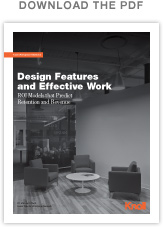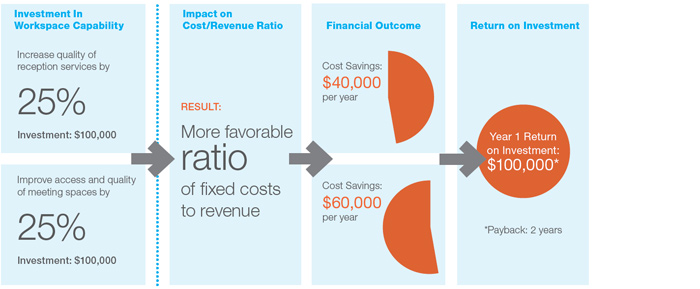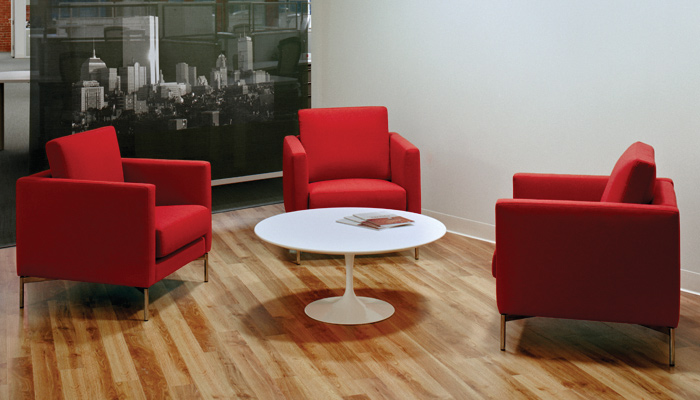
Background
Brain drain or human capital flight is a large emigration of individuals with technical skills or knowledge, due to lack of opportunity. This term was initially applied to whole countries or regions but has more recently been used to describe cases in which large numbers of key employees are leaving an individual company or industry. Brain drain is usually regarded as an economic cost, because those who depart usually take with them key skills, knowledge, experience and organizational memory that directly relates to the business success of the enterprise. In addition, engagement, brain drain and ultimately retention have an immediate cost related to recruitment and training of new employees.
Knoll, Inc. conducted a research project with a global management consulting firm to evaluate the effectiveness of its workspace strategy. The consulting employees of this organization have a highly mobile work style. As a result, the firm has policies, spaces, technology and administrative functions in place to support their unique requirements.
Two desired outcomes shape the firm’s workplace strategy: the need to keep important, mobile employees satisfied and engaged with their jobs (and thus manage retention and reduce organizational “brain drain”), and a requirement to control fixed facilities costs. Their response has been to provide, at each location, a variety of assigned and unassigned individual spaces, different sizes and types of meeting spaces with the right technology, and reception/administrative (“concierge”) support to ease the transition of employees who are constantly moving from one location to another to conduct their work.
Purpose
The purpose of this research was to determine what design features (if any) influence level of employee engagement and fixed facility costs. This study included employees at all locations, levels, job types and generational affiliation (Pre-Boomer, Baby Boomer, Generation X and Generation Y).
Key Findings: Design Features to Invest In
The research reveals that an organization can reduce fixed costs by investing to improve meeting space quality (number, size and availability) and effectiveness of administrative reception (concierge) support. To increase employee engagement, organizations can increase the proportion of individual work spaces, assigned workspaces, and quality of meeting spaces.
Methods
The data used in this study came from several sources:
-
An electronic survey which was administered by Knoll to about 150,000 employees at 194 office locations in 52 countries within the firm. The survey was administered in eight languages to ensure it was interpreted accurately, given its global context. Survey topics included assessment of: physical comfort, privacy, safety and security, access to appropriate meeting space, quality and accessibility of meeting spaces, and other factors. Employee demographic data were also collected: job type, job level, and generational affiliation.
-
A database with employee engagement data for each location. Data were collected as part of an existing annual program and the survey was administered by a third party consulting organization.
-
A real estate database with information about each facility location, including: fixed cost (excluding compensation) as a percentage of revenue, proportion of unassigned to assigned space, number of individual workspaces, square footage, and other facilities data per location.
Analyses
We combined the data from all these sources, including data from the 49,852 completed workplace surveys (which represents possibly one of the largest individual survey samples ever used in this type of study).
We included demographic characteristics of the population in the analysis (generational affiliation and job function) as well as site characteristics (such as density of individual workspaces and ratio of assigned to unassigned seats). We used a statistical technique called “multiple regression” (see panel at left, “What Makes Corn Grow”) to reveal relationships between design features and the outcome measures.
Outcome Measures and Definitions
We employed two outcome measures: cost as a percentage of revenue per location, and employee engagement scores. Both of these data sources were collected independent of the workplace survey and were supplied to us by the consulting organization.
Net Cost as a Percentage of Revenue
The net cost measure is a ratio that represents the fixed cost of each location (including rent, depreciation, utilities, janitorial services, capital interest, etc.—most of non payroll—and excluding minor costs like offsite storage, mail/postage, etc.) expressed as a percentage of revenue generated at that location.
Thus, this measure is more than just a reflection of cost, it is a measure of the efficiency of the investment in workspace in the context of revenue produced. For example, a location with a relatively high fixed cost (as a percentage of revenue) indicates the workspace is a less efficient business investment than a location with a lower fixed cost as a percentage of revenue.
Employee Engagement
An engaged employee is a person who is fully involved in, and enthusiastic about, his or her work. Employees with the highest level of commitment perform 20% better and are 87% less likely to leave the organization, which indicates that engagement is linked to organizational performance (Lockwood, 2007). Many studies over the years have routinely found that employee engagement scores account for as much as half of the variance in customer satisfaction scores. In a study of professional service firms, the Hay Group found that offices with engaged employees were up to 43% more productive (Watson-Wyatt, 2002).
For this study, employee engagement scores were collected by a reputable firm specializing in this type of work through a separate survey that assessed employee perceptions of: knowing job expectations, job recognition, feeling cared for at work, a belief that their opinions count, commitment to work quality, adequate social support at work, and feedback on progress, growth opportunities and other work related topics. Changes in employee engagement scores are used by companies to accurately predict future retention rates — and model future costs and shape programs to plan succession and avoid “brain drain” to the organization.
Engagement Scores and Employee Attrition Costs
It is also possible to use the overall engagement scores for an organization to predict attrition rates (voluntary separation) in employees. For instance, a reduction in engagement scores of .05 percent could predict an increase in overall employee turnover for a company of 0.75 percent. Many larger companies (including the one in this case study) know that predictive relationship. Thus, in this study, we were able to use engagement scores and related attrition costs in our analysis.
Results
We collected data from around the world and across languages and cultures. The analyses show that regardless of job type, gender, geography or generational affiliation, there are specific workspace design features and capabilities that directly contribute to outcomes such as employee retention and fixed costs. Thus, we feel these results can be generalized to any professional organization that needs to support highly mobile workers. In this section, we outline the study’s results and include a summary of the predictive ROI (return on investment) model we developed for each outcome.
Design Features that Influence Net Cost as a Percentage of Revenue
In this study, the definition of fixed cost (excluding compensation) is expressed as a percentage of revenue generated at each location. Thus, this measure is more than just a reflection of cost, it is a measure of the efficiency of the investment in workspace in the context of revenue produced. For example, a location with a relatively high fixed cost (as a percentage of revenue) indicates the workspace is a less efficient business investment than a location with a lower fixed cost as a percentage of revenue. Assuming a 1,000 employee office, the model demonstrates:
-
As quality of meeting spaces increases, and as quality of administrative reception capability increases, net facility costs (as a percentage of revenue) are reduced. Thus, investing to improve meeting space quality and effectiveness of reception (whether by adding staff or hiring more experienced employees) will reduce fixed costs, possibly because employees can more quickly make effective use of space in getting work done.

Figure 1. Return on investment model for fixed cost
Return on Investment Model for Fixed Cost
Figure 1 illustrates the logic of our ROI model which shows how the quality of meeting spaces and effective administrative reception support predict fixed cost as a percentage of revenue and actual cost savings.
-
Investment in Workspace Capability
Under the column “Investment in Workspace Capability” (see Figure 1) the model shows the two changes to the work and administrative environment. For the sake of this model, we made the assumption that a $100,000 investment in workspace design and furnishings would improve the quality of meeting spaces by 25% (see Figure 1). The model also shows a hypothesized $100,000 investment in the quality of administrative reception services that improves the quality of that function by 25% (see Figure 1). This investment could be applied to hire additional staff or more highly qualified administrative staff, providing training to staff, investing in technology tools, or making other investments.
-
Impact on Cost/Revenue Ratio
The regression model that we created showed that changes to these two facets of the working environment have a significant effect (to varying degrees), on fixed cost as a percentage of revenue (see Impact on Cost/Revenue Ratio column, Figure 1).
-
Financial Outcome
We were able to use the data from this regression model to provide estimates of the effect of investing in these changes not only on the cost/revenue ratio but also on actual cost outcomes (see Financial Outcome column, Figure 1). The model shows a $40,000 per year annual savings by investing to improve quality of reception services, and a $60,000 annual savings by investing to improve quality of meeting spaces.
-
Return on Investment
Our ROI model shows that investing a total of $200,000 to make the changes results in an annual cost reduction $100,000 with a payback of two years (see Return on Investment column, Figure 1).

Figure 2. Example ROI model for employee engagement
Design Features That Influence Employee Engagement
Figure 2 illustrates the logic of one part of our ROI model which relates the quality of meeting spaces with level of employee engagement and retention costs. Figure 2 shows a hypothesized $100,000 investment in workspace design and furnishings that improves the quality of meeting spaces by 25%. (In reality, of course it might cost more or less than that amount to increase employee perceptions of the quality of meeting spaces by 25%, but this is an assumption we make for this model.)
The research we conducted shows that a 25% improvement in meeting space quality will cause an overall increase in employee engagement of .003 units (see Figure 2). For this company, it is known that an increase in engagement of .003 units will reduce unwanted attrition by three full time employees per year. This company also knows that replacement costs for this job category is $250,000 per employee. Thus, our ROI model shows that investing $100,000 to improve meeting spaces by 25% results in a first year cost avoidance of $750,000 with a net return of $650,000 (after the initial $100,000 investment) (see Figure 2). The cost savings benefits are recurring and thus accrue over time. Our analyses also indicate that if additional investments were made to improve the proportion of assigned and individual spaces, additional gains in engagement and cost avoidance due to attrition would also be realized.
Recommendations
As a result of this study we have created four general workplace design recommendations that can help any organization supporting mobile workers reduce costs and maximize engagement and retention.
1. Creating a low proportion of individual workspaces within an office reduces fixed costs short term, but also reduces employee engagement, which our financial model shows is a much greater potential long term cost to organizations both in terms of immediate costs and longer term organizational effectiveness due to “brain drain” through loss of key employees.
There is no one “right” answer but we suggest as a starting point for workplaces serving highly mobile populations, at least 50% of all workspaces be designated for individual use at a given location—unless the majority of employees within the business unit or department using that space have a highly collaborative or team based style.
2. Generating a high proportion of unassigned workspaces reduces fixed costs, but also reduces employee engagement.
Organizations considering implementing unassigned workspaces, or increasing the proportion of this type of workspace should carefully consider the potential risk of this strategy in terms of workforce retention of key employees.
Whether your organization is currently using a strategy of unassigned workspaces, or is considering such a step, ensure that the policies, technology (for reservations, if used) and administrative support is carefully designed to smooth the transition of workers from their initial entry into the facility to their actual work within a workspace. Knoll’s experience and research initiatives demonstrate that easing the transition between workspaces is key to business effectiveness, and as this case study shows, engagement. While the right proportion of unassigned spaces will vary given the business model for each organization, we suggest that a mix of 20% unassigned workspaces at a given location can let you test the waters and optimize the space. Higher proportions of unassigned space will require additional investment in technology and administrative support.
3. Access to appropriate conference and meeting spaces enhances employee engagement, and reduces fixed costs.
This situation is a “win-win” and we recommend that any organization supporting mobile employees invest in a mix of appropriate meeting spaces at all their locations.
There is no “one size fits all” answer to the number, location and mix of meeting space sizes and types within a facility, but collecting information on factors such as: the general proportion of collaborative to individual work occurring at a given location, the proportion of mobile workers (who frequently arrive at a location to collaborate), typical meeting size, nature of meetings (videoconferencing versus face to face), proportion of planned versus unplanned meetings, and general culture and work style of employees can assist the planning process. Meeting spaces musthave the right technology for the varieties of work that will occur within them. These spaces should enable workers to switcheasily between collaborative work and more individual, task-focused activities.
4. Better administrative/reception capability reduces fixed costs.
For organizations that use reception or administrative services in a way that provides “concierge” support to mobile workers, we recommend continued investment in these resources because that strategy is actually shown to reduce fixed costs (as a percentage of revenue) within the facility, probably due to more effective use of space by visitors and less work downtime by these mobile employees.
Conclusion
Workspace requirements and strategies are never “cookie cutter” across organizations, but in this case study we have taken a first step: identifying several workspace features/capabilities that our research shows directly affect important business outcomes of fixed cost as a proportion of revenue, employee engagement and retention costs. As this paper illustrates, this research has even allowed us to create data-based ROI models that allow us to model potential incremental investment and improvement on key design features and understand their financial impact. The recommendations discussed in this paper can be applied to most organizations that are supporting a mobile workforce.
In addition, we have found in working with many organizations that a program to regularly assess internal customer workspace needs and satisfaction can be an effective means of anticipating space use trends and making best use of the capital deployed to house employees. This type of regular assessment also brings credibility to the facility management team when making the case to management for change and investment.
DOWNLOAD "Design Features and Effective Work" TO READ THE FULL PAPER
-
As the proportion of individual workspaces (whether assigned or unassigned) to square footage within a facility increases, employee engagement scores increase.
-
As the proportion of assigned workspaces to square footage within a facility increases, and as quality of meeting spaces increases, employee engagement scores increase.






















